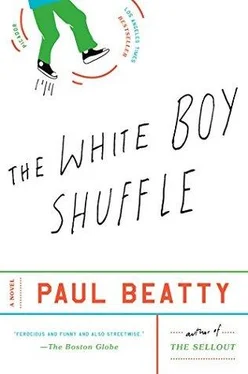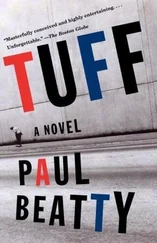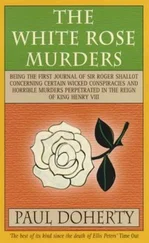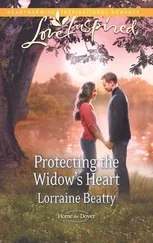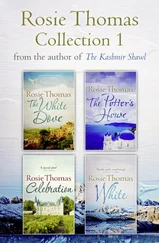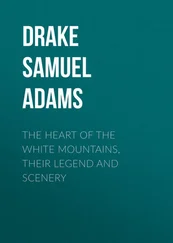Paul Beatty - The White Boy Shuffle
Здесь есть возможность читать онлайн «Paul Beatty - The White Boy Shuffle» весь текст электронной книги совершенно бесплатно (целиком полную версию без сокращений). В некоторых случаях можно слушать аудио, скачать через торрент в формате fb2 и присутствует краткое содержание. Год выпуска: 2001, Издательство: Picador, Жанр: Современная проза, на английском языке. Описание произведения, (предисловие) а так же отзывы посетителей доступны на портале библиотеки ЛибКат.
- Название:The White Boy Shuffle
- Автор:
- Издательство:Picador
- Жанр:
- Год:2001
- ISBN:нет данных
- Рейтинг книги:3 / 5. Голосов: 1
-
Избранное:Добавить в избранное
- Отзывы:
-
Ваша оценка:
- 60
- 1
- 2
- 3
- 4
- 5
The White Boy Shuffle: краткое содержание, описание и аннотация
Предлагаем к чтению аннотацию, описание, краткое содержание или предисловие (зависит от того, что написал сам автор книги «The White Boy Shuffle»). Если вы не нашли необходимую информацию о книге — напишите в комментариях, мы постараемся отыскать её.
The White Boy Shuffle — читать онлайн бесплатно полную книгу (весь текст) целиком
Ниже представлен текст книги, разбитый по страницам. Система сохранения места последней прочитанной страницы, позволяет с удобством читать онлайн бесплатно книгу «The White Boy Shuffle», без необходимости каждый раз заново искать на чём Вы остановились. Поставьте закладку, и сможете в любой момент перейти на страницу, на которой закончили чтение.
Интервал:
Закладка:
I don’t remember what the elephants were fighting about — something about hating each other for the colors of their sponge-rubbery skins. It wasn’t as if the black elephants had to use the mosquito-infested watering hole and rely on white elephant welfare for their quinine. After heavy casualties on both sides, a cease-tusking was called. The elephants, as wounded and bedraggled as elephants could possibly be, headed off into the hills, only to return to the plains years later as a harmonious and homogeneous herd of gray elephants.
I never could figure out why that story was so disquieting. Maybe it was the unsettling way Eileen Litmus would loudly slam shut her reader and stare at me from across the room as we completed the assignment at the end of the story.
1. Why did the elephants not get along? A folded note would soon find my hand under the desk.
2. How come the elephants came back gray? I’d open the note, trying my best not to rustle the paper. The scrawl read:
Fuck the stupid elephants. I like the tortoise and the hare story much more better. I challenge you to a race. Meet me after school for a race from the baseball diamond to the handball courts and back. Do you accept the challenge or are you a pigeon-toed wuss? P.S. You have big ears so you must be an African elephant.
3. Can we apply this story to real life? I’d look up and see Eileen’s hand raised high in the air, her eyes’ radar locked on mine. “Ms. Cegeny! Ms. Cegeny! Gunnar’s passing notes!” Ms. Cegeny would squeak her pudgy sandal-shod feet over to my desk and read the entire note to the shrieking delight of the class. As punishment for my misdemeanor, I’d have to stand up and read aloud my answer to the last question regarding the elephant story.
4. What do you think will happen to the elephants in the future? “Just like some human babies are born with tails or scales, some unfortunate baby elephants are going to be genetic flashbacks and come out albino white and summer’s nap black. Then the whole monochrome utopia is going to be all messed up.”
* * *
My first crush was on Stan “the Man” Musial, an old first baseman with a corkscrew batting stance who played for the St. Louis Cardinals in the 1940s and 1950s. Eileen Litmus was my second love. She had a vindictive sense of humor, power to left-center, and was faster than winter vacation, three qualities I admired in a third grader. Despite our age, Eileen and I were easily the fastest kids in the school. Kids would bet movie money on who would win our Friday marathons around the schoolyard backstops. The “Ready, get set, go!” often caught me flatfooted, staring at her lean figure, my arms frozen in prerace Tiberian Olympic-statue readiness. The sudden whoosh of Eileen’s departure would roust me from my trance, her thick dirty-blond hair streaming behind her like jet vapor, denim hip-huggers blurring past the tetherball courts. Pumping my arms and puffing my cheeks like I’d seen the track stars do on TV, I’d try to make up ground just so I could catch a glimpse of her round tan tomboyish face. If the grass near the hopscotch boxes was soggy and she wore the heavier Nike Cortezes, not the lighter Adidas running shoes, I stood a chance of catching her near the handball court, the inner thighs of my corduroys rubbing and buzzing down the stretch. Usually Eileen crossed the finish line first, wading into a welcoming committee of high fives and hugs from the girls. The boys wreathed me with humiliation. “Dude, why did you let her win? I lost four grape Pixie Stix. What the fuck is wrong with you, man? You’re supposed to be fast. When’s the last time a white sprinter won a race? Would you bowl with a white bowling ball? No, you wouldn’t.”
After a long schoolday of moralistic bombardment with the aphorisms of Martin Luther King, John F. Kennedy, Cesar Chavez, Pocahontas, and a herd of pacifist pachyderms, my friends and I were ready to think about color on our own terms. We’d make plans to spend the weekend at the beach, sunning in the shoreline’s warm chromatics and filling in childhood’s abstract impressionism coloring books with our own definitions of color, trying our hardest not to stay inside the lines.
Blue
Those without bikes rode on the handlebars. We pedaled side by side in wobbly tandems, yelling our blue profanities, sharing our blue fantasies. We bombarded the windows on the Big Blue municipal bus with wet baby-blue toilet-paper grenades. We splashed in the postcard blue of the ocean and stuck out our Slurpee blue tongues at the girls two towels over. Eileen’s light-saber blue eyes cut through me like lighthouse beacons lancing the midnight.
Psychedelic
When you’re young, psychedelic is a primary color and a most mesmerizing high. Santa Monica was full of free multihued trips. The color-burst free-love murals on Main Street seemed to come to vibrant cartoon life when I passed them. The whales and dolphins frolicked in the clouds and the sea lions and merry-go-round horsies turned cartwheels in the street. The spray-any-color-paint-on-the-spin-art creations at the pier were fifty-cent Jackson Pollock rainbow heroin hits that made your skin tingle and the grains of sand swell up and rise to the sky like helium balloons. Looking into the kaleidoscopic eyes of a scruffy Bukowski barfly sitting in the lotus position along the bike trails fractured your soul into hundreds of disconnected psychedelic shards. Each sharp piece of your mind begging for sobriety.
White
Santa Monica whiteness was Tennessee Williams’s Delta summer seersucker-suit blinding. The patchy clouds, the salty foams of the cresting waves, my friends, my style — all zinc oxide nose-cream white. My language was three-foot swells that broke left to right. “No waaaay, duuuude. Tuuubular biiitchin’ to the max. Tooootalllyyy fucking raaad.” White Gunnar ran teasingly tight circles around the recovering hollowed-out Narc Anon addicts till they spun like dreidels and dropped dizzily to the ground. White Gunnar was a broken-stringed kite leaning into the sea breeze, expertly maneuvering in the gusty gales. White Gunnar stabbed beached jellyfish with driftwood spears and let sand crabs send him into a disco frenzy by doing the hustle on his forehead. White was walking to school in the fog. White was ignoring the crossing guards and trying to outrun the morning moon. White was exhaling crystallized plumes of carbon dioxide and knowing it was the frozen exhaust of our excited minds. White wasn’t the textbook “mixture of radiations from the visible spectrum”; it was the opposite. White was the expulsion of colors encumbered by self-awareness and pigment.
Black
Black was an unwanted dog abandoned in the forest who finds its way home by fording flooded rivers and hitchhiking in the beds of pickup trucks and arrives at its destination only to be taken for a car ride to the desert. Black was hating fried chicken even before I knew I was supposed to like it. Black was being a nigger who didn’t know any other niggers. The only black folks whose names I knew were musicians and athletes: Jimi Hendrix, Slash from Guns n’ Roses, Jackie Joyner-Kersee, the Beastie Boys, and Melody the drummer from Josie and the Pussycats.
Black was trying to figure out “how black” Tony Grimes, the local skate pro, was. Tony, a freestyle hero with a signature model Dogtown board, was a hellacious skater and somehow disembodied from blackness, even though he was darker than a lunar eclipse in the Congo. The interviews in Shredder, Rollerbladers Suck, and Stoked magazines never mentioned his color.
Stoked: So, dude?
Tony: Yeah.
Stoked: Gnarly frontside ollie 180 fakie at the Laguna Pro-Am.
Читать дальшеИнтервал:
Закладка:
Похожие книги на «The White Boy Shuffle»
Представляем Вашему вниманию похожие книги на «The White Boy Shuffle» списком для выбора. Мы отобрали схожую по названию и смыслу литературу в надежде предоставить читателям больше вариантов отыскать новые, интересные, ещё непрочитанные произведения.
Обсуждение, отзывы о книге «The White Boy Shuffle» и просто собственные мнения читателей. Оставьте ваши комментарии, напишите, что Вы думаете о произведении, его смысле или главных героях. Укажите что конкретно понравилось, а что нет, и почему Вы так считаете.
